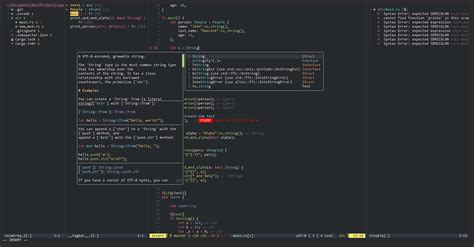The recent release of Neovim 0.10 has sparked excitement among developers, with a plethora of new features and enhancements. One common theme among user comments is the appreciation for Neovim’s efforts to simplify complex tasks and improve user experience. The addition of inlay Language Server Protocol (LSP) hints, tree sitter functionality, and better commenting capabilities has been well-received by the community. These core updates cater to both seasoned Neovim users and newcomers, making the transition seamless and offering immediate benefits.
One of the key highlights of this release is the increased focus on core features, reducing the reliance on external plugins. Many users have shared their struggles with plugin maintenance and compatibility issues, leading them to seek a more minimal and efficient setup. Neovim’s commitment to enhancing built-in functionalities like clipboard integration (OSC 52 escape sequence support) and default color schemes reflects a shift towards a more self-sufficient editor, reducing the need for extensive plugin configurations.
While Neovim remains true to its minimalist roots, the demand for additional features has prompted users to explore various plugins and distributions like LazyVim, AstroNvim, and LunarVim. These offshoot projects offer tailored solutions for users seeking a more robust IDE-like experience while leveraging Neovim’s extensibility. The community’s continuous innovation and experimentation with configurations and LSP integrations showcase the versatility and adaptability of Neovim beyond its core functionalities.
The ongoing debate between Neovim and Vim loyalists highlights the evolving landscape of text editors and the diverse needs of developers. While Neovim’s core focus on extensibility and minimalism appeals to many, some users express concerns about performance discrepancies compared to Vim, terminal integration, and workflow efficiency. Neovim’s journey towards a refined and polished user experience involves balancing modern features and usability with the editor’s legacy and stability.
The user feedback on the Neovim 0.10 release underscores the editor’s ongoing evolution and its impact on developer workflows. From core enhancements to GUI considerations, the Neovim project continues to push boundaries and redefine user expectations in the text editor market. As Neovim gains traction and community support, the development roadmap promises further advancements in usability, performance, and extensibility, setting the stage for a new era of code editing.
In conclusion, Neovim’s journey from a Vim fork to a powerhouse editor reflects the dynamic nature of software development tools and the collaborative efforts of the open-source community. As developers embrace Neovim’s modern features, integrated capabilities, and customizable options, the editor’s popularity continues to grow. Whether you are a seasoned Neovim user, a curious newcomer, or a dedicated Vim aficionado, the advancements in Neovim 0.10 signal a promising evolution in code editing productivity and user experience.


Leave a Reply